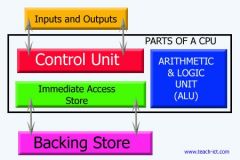![]()
![]()
![]()
Use LEFT and RIGHT arrow keys to navigate between flashcards;
Use UP and DOWN arrow keys to flip the card;
H to show hint;
A reads text to speech;
15 Cards in this Set
- Front
- Back
|
1) What is the purpose of the CPU?
2)Where does CPU fetch the data and instructions from and where does it store them? |
1) The purpose of CPU is to process data
2)The CPU gets the information and data from its main memory and stores it in its own internal temporary memory areas. |
|
|
3) What is the name of the internal temporary memory areas?
4) For the fetch part of the cycle to happen, the CPU places the address of the next item in a vital hardware path. What is this called? |
3) They are called “registers”
4) It is called the “address bus” |
|
|
5) Data from this bus then moves from the main memory into the CPU by travelling along another bus. What is its name?
6) The next step is for the CPU to make sense of the instructions, what is this process called? |
5) It is called the “data bus”
6) The name of it is “Decode” |
|
|
7) The CPU is designed to understand a specific set of commands which are different for every make of CPU. What are these set of commands called?
8) The CPU decodes the instructions but what does it do next? |
7) They are called “instruction set”
8) The next step is execute |
|
|
9) What is the name of the part of the cycle where the actual data processing takes place?
10) What does the Fetch Decode Execute Cycle look like? |

9) It is called “execute”
10) (see diagram) |
|
|
11) Draw the main part of a CPU diagram
|

11) (see diagram)
|
|
|
12) List the three main jobs of the control unit.
|
12)
1) Controls and monitors the hardware of the system to make sure it is following instructions 2) Controls the input and output of data 3) Controls the flow of data in the CPU |
|
|
13) The CPU reads data and programs kept on the backing storage, but where does it store it?
14) Why does the CPU need to store data and programs in the IAS? |
13) It stores it temporarily in the IAS’s memory
14) It does this because the Backing Storage is too slow to run a program directly |
|
|
15) The ALU manipulates or acts upon the data. List the name of the parts of the ALU and say what they do?
16) How many instructions can a computer process at any one time? |
15) Arithmetic Part-It performs the calculations of the data
Logic Part-Performs logic and comparisons 16) Only one at a time, even though it may seem like more |
|
|
17) How is the clock speed measured?
18) How many instructions per second would a computer running at 3GHz carry out? |
17) It is measured by cycles per second. (1 cycle per second is known as 1 Hertz)
18) 3GHz = three thousand million instructions per second (modern desktop speed) |
|
|
19) The faster the speed the better the performance, but what is the downside of this fact?
|
19) It will become hotter (become hotter more quickly) and it uses more power
|
|
|
20) What does “overclocking” mean?
|
20) Overclocking is programming the CPU to run faster than what it was designed to do. Because you have done this the computer will get hotter quicker, it will use more power and extra fans have to be bought.
|
|
|
21) Explain what the term dual core means.
22) List, starting with the first one it looks at, the order the CPU looks at different storage areas it can access. |
21) Dual Core means running two CPU’s at once. This means you can truly run parallel processing when running programs.
22) Cache System Memory |
|
|
23) The cache memory is known as volatile memory. Explain the term volatile.
|
23) Volatile means when something it is shut down, everything is lost.
So because the cache memory is volatile, when the computer is shut down, anything stored there is lost. |
|
|
24) If the cache is larger how does this affect the performance of the CPU?
|
24) Overall the performance will be better because more data is stored locally.
|

